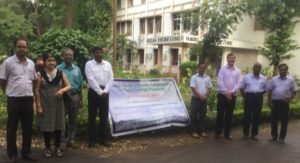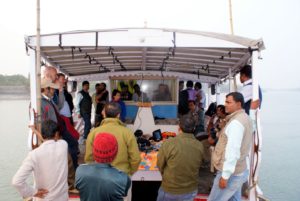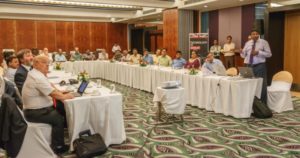19th August 2016 Bangalore, India
UK-India partnership making waves in the Sunderbans
Last year I had the opportunity to manage an incredibly exciting project on UK-India Cooperation on Tidal Power Research, which included several visits from the UK Centre for Marine Energy Research (UKCMER), hosted at the University of Edinburgh. This builds on our efforts from 2014 when UKCMER members visited Kolkata and the Sunderbans to look at the potential of our collaboration with India on wave and tidal energy.
Why the Sunderbans?
The Sunderbans is one of the three areas in India with the potential for tidal power generation. Previous attempts to develop a viable tidal power project in the Sunderbans have been unsuccessful due to various reasons including concerns relating to the cost efficiency of the project and the impact of the proposed tidal barrage technology on the ecology and habitat of the Sunderbans.
During the former Energy and Climate Change minister Greg Barker’s visit to Kolkata in 2012 and 2014, possible collaborations with the Government of West Bengal (GoWB) in exploring tidal energy potential in the Sunderbans was discussed, considering the UK’s reputation as a global leader in tidal energy research and technology development.
Building up UK-India co-operation
The result was the Science and Innovation Team inviting UKCMER to meet with officials from the West Bengal Renewable Energy Development Agency (WBREDA) and also visiting the Sunderbans. The research remit of UKCMER, with funding from the Engineering and Physical Sciences Research Council, seeks to engage developers, industry, academia and other stakeholders to conduct fundamental and applied research that accelerates deployment of marine renewable energy. This visit helped lay the foundation of this tidal energy partnership and made a number of key recommendations:
1. The tidal current technology (which for you engineers out there!) – a three bladed horizontal axis rotor and generator system, similar to wind turbines – is the most suitable and least disruptive form of tidal power generation for an ecologically sensitive region such as the Sunderbans, its wildlife, aquatic life and the economic activities of the local people.
2. A resource mapping exercise would be essential for identifying the best possible sites and selecting appropriate technology to be deployed at these sites.
3. The UK has a lot of expertise in tidal energy research, resource assessment and development and would be willing to undertake joint deployment of these technologies in the Sunderbans as part of its commitment to reducing global carbon footprint.
4. Building local capacity in resource mapping and installing these technologies would be crucial to such a collaborative initiative.

UKCMER visit the Sunderbans
We worked closely with Professor Robin Wallace, Executive Director of UKCMER, and with generous support from IIT-Kharagpur (IIT-Kgp) and Jadavpur University (JU), began a Tidal Energy Research project with the Sunderbans at its heart. We put together workshops, meetings with GoWB officials and universities and field visits to ensure we had the right skills, facilities and data to support any deployment of tidal energy technologies. An initial visit in August 2015 laid the ground work through meetings with the Government of India’s Ministry of New and Renewable Energy and the West Bengal Government’s Power Department, and a workshop at IIT-Kharagpur with researchers from the institute and Jadavpur University.
 Our UK team – consisting of Professors Wallace, David Ingram and Venugopal – came back in early 2016. With thanks to JU, the team this time met with local villagers to understand their sources of livelihood and their electricity needs and use. The villagers were briefed on the project and how electricity could be generated from tides through turbines. In a matter of days the team developed two research proposals: one for developing a “numerical model” of tidal flow in the region and the other a more comprehensive assessment of tidal resources and a feasibility study. The following month, the Jadavpur team, with support from the UK researchers, successfully secured a grant from the UK’s Prosperity Fund to carry out the first phase of the study on tidal flow modelling.
Our UK team – consisting of Professors Wallace, David Ingram and Venugopal – came back in early 2016. With thanks to JU, the team this time met with local villagers to understand their sources of livelihood and their electricity needs and use. The villagers were briefed on the project and how electricity could be generated from tides through turbines. In a matter of days the team developed two research proposals: one for developing a “numerical model” of tidal flow in the region and the other a more comprehensive assessment of tidal resources and a feasibility study. The following month, the Jadavpur team, with support from the UK researchers, successfully secured a grant from the UK’s Prosperity Fund to carry out the first phase of the study on tidal flow modelling.
Braving the unpredictable weather of the Sunderbans, the JU team, led by Prof Sugata Hazra, completed data collection from Durgaduani and Satjelia within the stipulated period of a month. From this data, the Edinburgh team developed a numerical model of tidal flow in the Sunderbans followed by an estimation of energy potential from the possible sites. An assessment of environmental and social impact was undertaken by our NGO project partner to inform the study.
Bringing tidal energy to the Sunderbans – a step closer
The UKCMER team returned again in May 2016 to present their findings, together with JU, at a stakeholder meeting in Kolkata, which was attended by over 35 participants from the State Government agencies, civil society and academics working on renewable energy and the Sunderbans. The team had a stimulating and vibrant discussion with the stakeholders, who showed a strong support for a pilot project in the Sunderbans. What’s exciting is that the Edinburgh team has recently been awarded funding, through the EPSRC Global Challenge Research Fund, to extend the numerical modelling work for the Sunderbans in partnership with IIT-Kgp and JU.
 At present we continue to look for funding to undertake a detailed resource assessment study. But the significant steps we’ve taken to build UK-India co-operation in West Bengal feed into our broader efforts to collaborate with India in the area of energy, which was a key focal area of PM Modi’s visit last November. So I’m very excited to contribute to this effort.
At present we continue to look for funding to undertake a detailed resource assessment study. But the significant steps we’ve taken to build UK-India co-operation in West Bengal feed into our broader efforts to collaborate with India in the area of energy, which was a key focal area of PM Modi’s visit last November. So I’m very excited to contribute to this effort.

Great to see these initiatives between the UK and India happening. There is some exciting technology out of Cambridge, http://www.oceanarraysystems.com/, doing tidal work so you should speak to Tom Clark, CEO, if they can contribute.
It is indeed a very good effort for exploring the ocean energy into reality. I feel there is one potential laboratory in India i.e. National Institute of Oceanography and the department of marine Science, Calcutta University are missing from these effort. It would have been very fruitful if scientist from the National Institute of Oceanography would have participated.
Any way, it is an excellent effort to use the ocean energy for the benefit of mankind.
Best effort by our P.M Modi